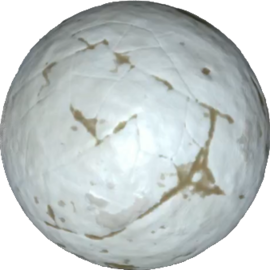Eeloo
Eeloo is a dwarf planet that was released in version 0.18.2 as a Christmas gift to the KSP community. It is the seventh and farthest planet from Kerbol most of the time, though its orbit intersects Jool's, passing in front of it for a minority of its revolution period. The two planets are locked in a 3:2 resonance, which, coupled with their different inclinations, ensures they cannot collide. Eeloo has just 3.5% more gravity than the Mun and is very similar in size. Like the Mun, it has no atmosphere. The physical characteristics of Eeloo are most likely an analogue of the ice moon Europa, and its orbit is similar to that of Pluto, though both bodies are known to have a tenuous atmosphere. Eeloo's relatively large distance from Kerbol reduces solar power to approximately 1/2 to 3/8 of the values seen at Kerbin. Bringing additional panels, or an alternate powersource (e.g.: RTGs) is recommended. There is a tutorial about How to get to Eeloo.
In-game Description
There’s been a considerable amount of controversy status of Eeloo as being a proper planet or just a lump of ice going around the sun. The debate is still ongoing, as most academic summits held to address the issue have devolved into, on good days, petty name calling, and on worse ones, all-out brawls.
Topography
The surface of Eeloo is relatively smooth and covered in gray-white ice, with deep canyons exposing the brownish rock below. A few craters are visible, but not nearly as one might expect for a body without an atmosphere. Its highest points are near the equator and are almost 3.9 km high, while the lower areas can go lower than sea level. Eeloo's surface lacks ground scatter, suggesting the ice on the surface is subject to erosion of some sort. It originally had an atmosphere, but it has been removed because the renderer for it doesn't work on bodies smaller than about Duna's size
Orbits
Eeloo's distant, eccentric and inclined orbit, in addition to its low gravity, make encounters challenging. Its distance from Kerbin also tends to make missions very lengthy. A synchronous orbit around Eeloo is possible, at an altitude of ~683.9 km.
Communication
Using the Remote Tech plugin, path lengths from Kerbin can reach up to around 127 Gm (127 billion meters), resulting in a round trip delay longer than 14 minutes. Even at the closest approach, the communication delay is more than 6 minutes.
Future
There were plans for Eeloo to become the moon of a second gas planet and have an active surface, with cryovolcanic phenomena. It is unknown what Eeloo's parent planet was intended to look like, but according to former developer NovaSilisko Eeloo was to be the innermost moon of three other major moons.
Reference Frames
| Rotational/Inertial transition | 100.000 m |
|---|---|
| Warp | Minimum Altitude |
| 1× | Any |
| 5× | 4000m |
| 10× | 4 000 m |
| 50× | 20 000 m |
| 100× | 30.000 m |
| 1.000× | 40.000 m |
| 10.000× | 70.000 m |
| 100.000× | 150.000 m |
